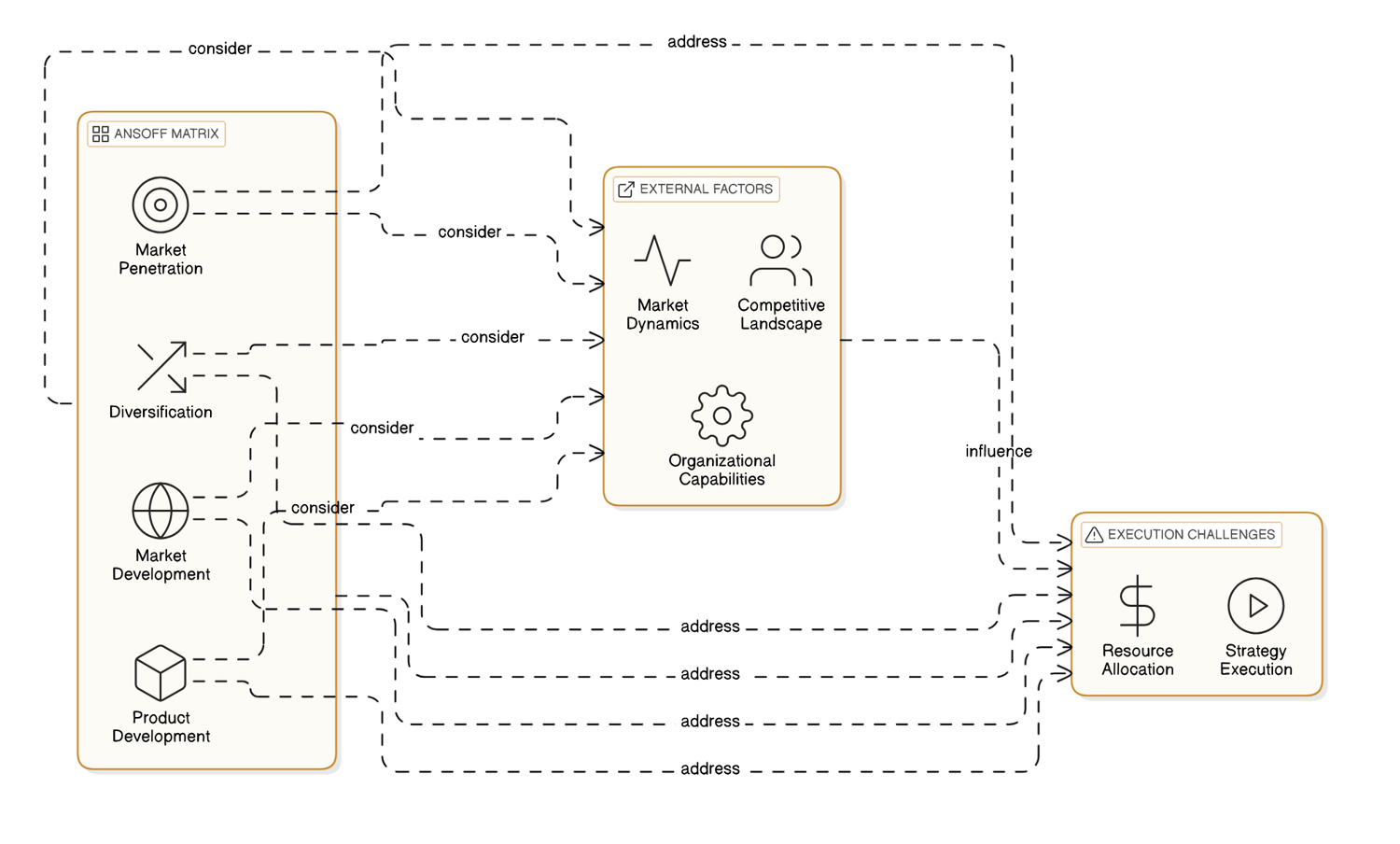Summary
This article delves into mastering the Ansoff Matrix as a crucial tool for strategic planning. It highlights its practical applications in today`s fast-paced business environment, offering valuable insights that resonate with both seasoned strategists and newcomers alike. Key Points:
- Explore dynamic applications of the Ansoff Matrix by integrating data analytics for real-time strategy adjustments, enhancing decision-making based on market feedback.
- Utilize AI and machine learning to uncover hidden market opportunities and personalize marketing strategies, significantly improving the effectiveness of Ansoff`s approaches.
- Adapt the Ansoff Matrix to incorporate sustainability and ESG factors, assessing long-term impacts beyond just financial returns in strategic planning.
What is the Ansoff Matrix and Why Should You Care?
A Startup’s Struggle: How Misusing the Ansoff Matrix Led to Failure
But… things didn’t go as planned. The bins, priced at $299 each, were too expensive for their target market. By Q2, only 12% of the projected sales were achieved. "Honestly, we thought the Matrix would just work," Emma admitted. "We didn’t account for the price sensitivity."
The marketing team tried to pivot, offering discounts and promotions, but the damage was done. Expenses piled up, and morale dipped. "It felt like we were throwing money into a black hole," said Jake, the operations lead. By early 2023, GreenCycle had to halt production and rethink their strategy.
Looking back, Emma sighed, "We misused the Matrix. It’s not a magic formula—it’s a tool, and we didn’t adapt it to our reality." The team sat in silence, the weight of their misstep sinking in.
| Dimension | Market Penetration | Market Development | Product Development | Diversification |
|---|---|---|---|---|
| Definition | Increasing sales of existing products in existing markets | Entering new markets with existing products | Developing new products for existing markets | Creating new products for new markets |
| Focus | Maximizing market share and increasing customer base within current demographics | Exploring geographical or demographic segments not currently served by the business | Enhancing product offerings to meet consumer demands and preferences more effectively | Risky strategy involving both new products and new markets, often requiring innovation |
| Risk Level | Low to moderate risk as it builds on established capabilities and knowledge of current market conditions. | Moderate risk due to uncertainty in understanding the dynamics of new markets. | Moderate to high risk depending on how different the new product is from the existing ones. | High risk as it involves unknowns in both product development and market acceptance. |
| Example Strategies | Sales promotions, loyalty programs, improving distribution channels | International expansion, targeting different age groups or income levels | Introducing variations or improvements to current product lines, launching complementary goods | Entering a joint venture for a completely novel solution or acquiring startups with innovative technologies |
The Turning Point: How One Company Found Success with the Ansoff Matrix
The room fell quiet. Some team members started flipping through their notes, while others just stared at the ceiling. "We thought we’d nailed it this time," Sarah admitted, her voice trailing off. "But… something’s still off."
By Q4, the pressure was palpable. "We’re burning through cash," Mark said bluntly during a strategy meeting. "If we don’t fix this soon, we’re looking at layoffs." The word hung in the air. No one wanted to say it, but everyone was thinking it.
Then, a breakthrough. In early 2023, the team revisited the Matrix, focusing on "Market Penetration" instead. "Maybe we’re trying to reinvent the wheel," Sarah suggested. They streamlined the product, slashed prices, and targeted existing customers with aggressive marketing. By Q2, sales jumped by 65%. "Finally," Mark sighed, "we’re moving in the right direction."
The turning point wasn’t just about the numbers—it was about realizing the Matrix wasn’t a one-size-fits-all solution. "We had to adapt," Sarah said, "and that made all the difference."
Our Approach to Helping Businesses Master the Ansoff Matrix
Initial workshops focused on Market Penetration, but results were mixed. “We tried aggressive pricing,” one team member said, “but margins took a hit.” Another added, “The feedback was inconsistent—some customers loved it, others didn’t see the value.”
By mid-year, the team shifted to Diversification, launching a pilot product. “It felt risky,” Sarah admitted, “but we had to try something new.” Early sales were underwhelming, and doubts resurfaced. “Is this even the right direction?” a team member questioned during a strategy meeting.
Despite incremental progress, uncertainty remains. “We’re making adjustments,” Mark said, “but it’s too early to call this a success.”

 Free Images
Free ImagesFrequently Asked Questions About the Ansoff Matrix
For instance, if you're operating in a saturated market where competition is fierce, focusing on Market Penetration might be your best bet. This involves leveraging your existing products to gain more market share—think about how companies often offer promotions or enhanced customer service to attract more customers within the same market. On the other hand, if you’re looking at entering new markets with innovative products, Diversification can seem like an exciting but risky venture.
💡 A little tip: Always assess your organization’s strengths before diving into any strategy! It’s crucial to have a clear understanding of what resources you have at your disposal and how they align with your growth ambitions.
Another frequent question is, "Isn’t diversification too risky?" Well, while it does carry higher risks due to unknown factors in new markets and products, it can also lead to significant rewards if done correctly. Companies like Apple are great examples—they continuously diversify by creating new product lines while still maintaining their core offerings.
In essence, choosing the right approach using the Ansoff Matrix requires careful consideration of both external opportunities and internal strengths. By doing so, you can create strategies that not only aim for growth but also fit seamlessly into your long-term goals!
Is the Ansoff Matrix Still Relevant in Today’s Market?
The Debate: Does the Ansoff Matrix Oversimplify Strategy?
Step-by-Step Guide: How to Apply the Ansoff Matrix Effectively
In today’s fast-paced business environment, having a solid growth strategy is essential. The Ansoff Matrix serves as a powerful tool for organizations seeking to navigate their growth options effectively. By categorizing strategies into four distinct quadrants—Market Penetration, Market Development, Product Development, and Diversification—it allows businesses to assess their current position and identify future opportunities.
Reflecting on my own experience with the Ansoff Matrix, I remember when a colleague struggled with deciding whether to launch a new product or expand into an untapped market. After applying this framework, we gained clarity on our direction and ultimately made informed decisions that led to successful outcomes. Many people overlook how strategic frameworks can streamline complex decisions; thus, let’s delve into practical steps for applying the Ansoff Matrix in your organization.
#### Step 1: Analyze Your Current Situation
Begin by assessing your existing market share and product lines. Gather data on both customer demographics and competitors’ positioning. Tools like SWOT analysis can help clarify strengths and weaknesses that may influence your chosen strategy.
#### Step 2: Define Your Objectives
What do you aim to achieve? Whether it’s increasing revenue or enhancing brand recognition, setting clear objectives will guide you through each quadrant of the matrix (I often jot down my goals in a dedicated notebook 📒 so they’re always top of mind).
#### Step 3: Explore Market Penetration Strategies
In this quadrant, focus on tactics such as competitive pricing or promotional campaigns aimed at existing customers. Consider tools like A/B testing for marketing strategies—this way you can optimize campaigns based on real-time feedback.
#### Step 4: Investigate Market Development Opportunities
Identify potential new markets for your existing products. Conduct thorough research using resources like industry reports or surveys to understand regional demands and preferences—localization is key! (Pro tip: Engage local influencers who can provide insights into cultural nuances.)
#### Step 5: Innovate with Product Development
Emphasize R&D efforts here by exploring customer feedback loops and trend analysis. Utilize brainstorming sessions with cross-functional teams to generate innovative product ideas tailored for current customers (I find it helpful to have sticky notes handy during these sessions for capturing spontaneous thoughts!).
#### Step 6: Approach Diversification Wisely
This step involves more risk but also greater reward potential. Look into partnerships or acquisitions that align with your long-term vision while expanding both market reach and product offerings (don’t forget due diligence; understanding financial health is crucial before diving in).
As you implement these steps, remember that flexibility is vital—adjust strategies based on performance metrics periodically reviewed against set objectives.
For those looking deeper into applications of the Ansoff Matrix, consider integrating scenario planning techniques alongside it. This could involve mapping out potential challenges within each quadrant based on external factors like economic fluctuations or technological advancements.
If you're eager to refine your approach further or explore advanced methods like portfolio management aligned with the Ansoff framework, don't hesitate! Embrace experimentation—after all, adapting strategies over time can lead not only to sustained growth but also innovation within your field.

What’s Next? Exploring the Future of Strategic Planning
Key Takeaways and Actionable Insights from the Ansoff Matrix
As we navigate ever-evolving market dynamics, it’s essential to recognize that trends are continuously shifting. Businesses must remain agile and adaptive in responding to these changes. Therefore, implementing pilot programs not only mitigates risk but also allows for real-time feedback on strategies' effectiveness.
Now is the time to take action—evaluate your organization’s current position within the Ansoff Matrix framework and identify which strategy aligns best with your goals. The opportunities for growth are abundant if you’re willing to pivot and innovate. Embrace this strategic tool today and discover how it can lead you toward sustainable success!
Reference Articles
策略規劃與管理實務:經理人培養思維、掌握洞察力
安索夫的Ansoff Matrix(第十四篇)及策略大師亞瑟. 理特的ADL Matrix(第十五篇)。 藉由這兩篇文章,可以認識兩位策略大師的生平及思想,並深入瞭解這兩種工具的定義與 ...
Source: 博客來安索夫戰略
... 應用研究一定要“做下里巴人”,明確界定自己研究出來的程式、工具,明確界定它的應用對象、範圍和考評的方法,達到工具應用的目的。 由於戰略管理理論的迅猛發展,不少 ...
Source: MBA智库百科給主管的管理索引
安索夫矩陣Ansoff Matrix 由「策略管理之父」安索夫提出,用來分析各產品在不同市場的發展策略。 以「新/現有產品」為橫軸,「新/現有市場」為縱軸,區分出4種產品策略和 ...
Source: 經理人策略規劃與管理實務:經理人培養思維、掌握洞察力
綜觀旭群這本書的內容,31篇文章的主題其涵蓋面比較廣,其內容亦綜合了與策略規劃相關的理論與實務性,並且把一些似是而非的觀念講述的相當清楚,我認為本書是企業在進行策略 ...
Source: 五南官網策略規劃與管理實務: 經理人培養思維、掌握洞察力
內容簡介. 內容簡介由策略思維到策略執行,建構新時代必備的策略洞察力․理論與實務兼具:深入淺出說明理論並佐以實際案例,提高讀者在學習或實務工作時的吸收。
Source: 誠品BCG矩陣是什麼?從4 象限找到產品定位、幫企業規劃策略
BCG矩陣可以應用在市場定位、產品定位、現況分析,以及產品生命週期上。公司根據不同的BCG矩陣象限特徵,調整產品後續的策略,確保公司能持續獲利,並提升工作效率。以下將介紹 ...
Source: Welly SEO安索夫战略
安索夫 在战略管理中的特殊地位最主要表现在对战略管理(Strategic Management)的开创性研究,由于他的开创性研究终于使他成为这门学科的一代宗师。作为战略管理的一代宗师,他 ...
Source: MBA智库百科


 ALL
ALL Seo Technology
Seo Technology
Related Discussions